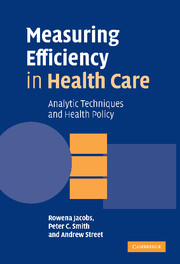Book contents
- Frontmatter
- Contents
- List of figures
- List of tables
- Preface
- Acknowledgements
- List of abbreviations
- 1 Efficiency in health care
- 2 The components of an efficiency model
- 3 Stochastic frontier analysis of cross-sectional data
- 4 Stochastic frontier analysis of panel data
- 5 Data envelopment analysis
- 6 The Malmquist index
- 7 A comparison of SFA and DEA
- 8 Unresolved issues and challenges in efficiency measurement
- 9 Some alternative approaches to measuring performance
- 10 Conclusions
- Appendix: Data description
- References
- Author index
- Subject index
6 - The Malmquist index
Published online by Cambridge University Press: 10 December 2009
- Frontmatter
- Contents
- List of figures
- List of tables
- Preface
- Acknowledgements
- List of abbreviations
- 1 Efficiency in health care
- 2 The components of an efficiency model
- 3 Stochastic frontier analysis of cross-sectional data
- 4 Stochastic frontier analysis of panel data
- 5 Data envelopment analysis
- 6 The Malmquist index
- 7 A comparison of SFA and DEA
- 8 Unresolved issues and challenges in efficiency measurement
- 9 Some alternative approaches to measuring performance
- 10 Conclusions
- Appendix: Data description
- References
- Author index
- Subject index
Summary
Introduction
When longitudinal data or panel data are available, the most common approach in the data envelopment analysis literature is to apply a Malmquist index of the change in total factor productivity (TFP). This chapter outlines the distinctive features of the Malmquist index, along with key issues in specifying a Malmquist DEA model. We describe some of the applications of the Malmquist index in the health care sector, provide a graphical illustration of the Malmquist methodology, and outline some considerations when applying the Malmquist model, before turning to a case study of acute hospitals in England.
Index numbers are used to measure the change in TFP and involve the measurement of changes in the levels of output produced and input used. The most popular indices are the Laspeyres, Paasche, Fisher and Törnqvist (Laspeyres 1871; Paasche 1874; Fisher 1922; Törnqvist 1936). All index numbers measure the changes in the levels of a set of variables between a base period and the current period. The Laspeyres index uses the base period quantities or prices as weights, whereas the Paasche index uses the current period weights. The Fisher index is the geometric mean of these two indices. The Törnqvist index is often presented in a log-change form and represents the weighted average change in the log of the price or quantity of a particular commodity.
- Type
- Chapter
- Information
- Measuring Efficiency in Health CareAnalytic Techniques and Health Policy, pp. 129 - 150Publisher: Cambridge University PressPrint publication year: 2006



